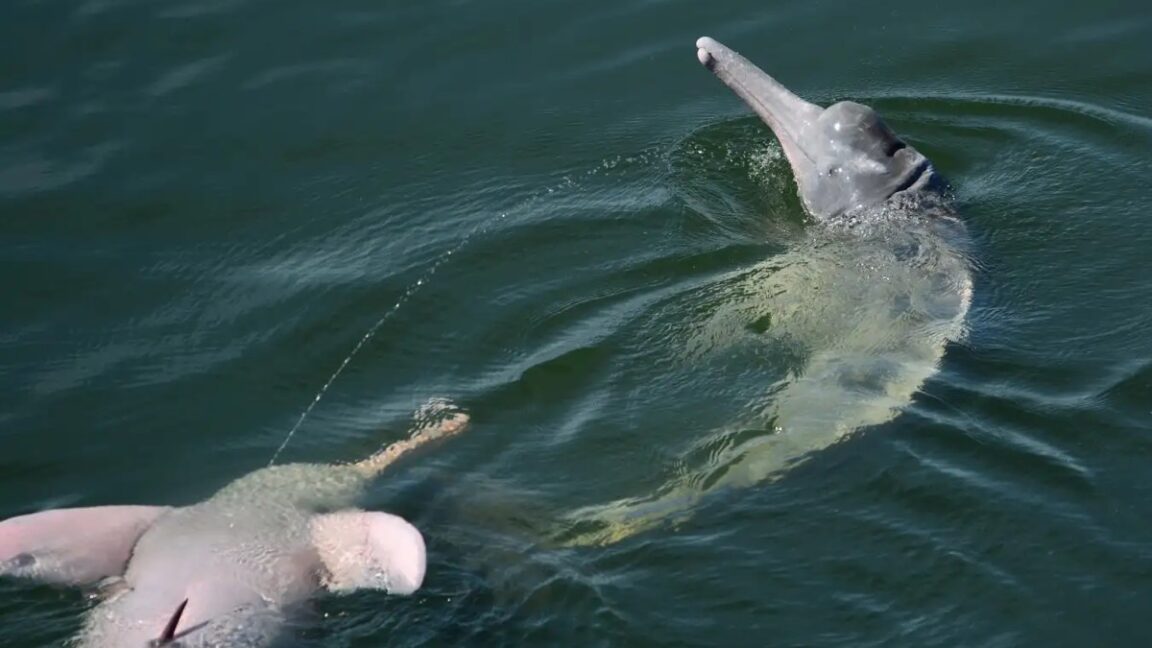
Let us spray: River dolphins launch pee streams into air
arstechnica.com
going with the flow Let us spray: River dolphins launch pee streams into air It's unclear why river dolphins do this, but it might serve some kind of social function. Jennifer Ouellette Feb 3, 2025 3:14 pm | 0 Credit: Claryana Arajo-Wang / Botos do Cerrado Research Project / CetAsia Research Group Credit: Claryana Arajo-Wang / Botos do Cerrado Research Project / CetAsia Research Group Story textSizeSmallStandardLargeWidth *StandardWideLinksStandardOrange* Subscribers only Learn moreAccording to Amazonian folklore, the area's male river dolphins are shapeshifters (encantade), transforming at night into handsome young men who seduce and impregnate human women. The legend's origins may lie in the fact that dolphins have rather human-like genitalia. A group of Canadian biologists didn't spot any suspicious shapeshifting behavior over the four years they spent monitoring a dolphin population in central Brazil, but they did document 36 cases of another human-like behavior: what appears to be some sort of cetacean pissing contest.Specifically, the male dolphins rolled over onto their backs, displayed their male members, and launched a stream of urine as high as 3 feet into the air. This usually occurred when other males were around, who seemed fascinated in turn by the arching streams of pee, even chasing after them with their snouts. It's possibly a form of chemical sensory communication and not merely a need to relieve themselves, according to the biologists, who described their findings in a paper published in the journal Behavioral Processes. As co-author Claryana Arajo-Wang of CetAsia Research Group in Ontario, Canada, told New Scientist, We were really shocked, as it was something we had never seen before.Spraying urine is common behavior in many animal species, used to mark territory, defend against predators, communicate with other members of one's species, or as a means of mate selection, since it has been suggested that the chemicals in the urine carry useful information about physical health or social dominance.The behavior is much rarer among aquatic species, although the authors note that male African cichlids expel pulses of urine to mark territory and in certain reproductive contexts. In the narrow-closed crayfish, a marked decrease in male aggression has been observed when one crayfish detects the other's urine, "suggesting that urine may aid individual recognition while also carrying information about the sender's aggressive propensity," the authors wrote. It has been suggested that urine might indicate a readiness to mate in certain cetaceans, although evidence for this is scarce.So naturally Arajo-Wang et al. were surprised to see so many instances of "aerial urination" while conducting their land-based surveys in the Tocantins River from 2014 to 2018, recording nearly 219 hours of dolphin activity. Sometimes it was just a single male dolphin launching his stream (the "urinator"), but two-thirds of the occurrences involved at least one other male dolphin (the "receivers") lurking nearby and sometimes positioning themselves directly under the urine stream. The urine releases lasted about 11 seconds on average, with one second being the shortest duration and 41 seconds being the longest.It's possible this is a form of chemical communication. While dolphins lack a strong sense of smell or taste, there is evidence that they can detect some odorants and secretions in both air and water, per the authors, including the urine and feces of their fellow dolphinsnamely bottlenose dolphins, who use their tongues to identify fellow dolphins through the taste of their urine. Another possibility is that the urine hitting the water serves as an acoustical signal, given how sensitive dolphins are to sound. Or maybe the male dolphins just like to admire their own urine streams.DOI: Behavior Processes, 2025. 10.1016/j.beproc.2025.105149 (About DOIs). Amazon river dolphins may send messages with aerial streams of urine. Jennifer OuelletteSenior WriterJennifer OuelletteSenior Writer Jennifer is a senior writer at Ars Technica with a particular focus on where science meets culture, covering everything from physics and related interdisciplinary topics to her favorite films and TV series. Jennifer lives in Baltimore with her spouse, physicist Sean M. Carroll, and their two cats, Ariel and Caliban. 0 Comments
0 Комментарии
·0 Поделились
·56 Просмотры


